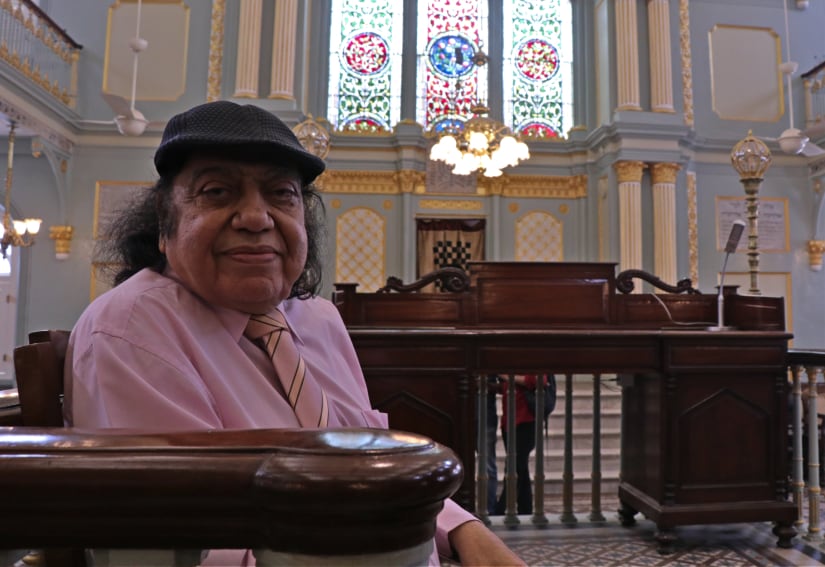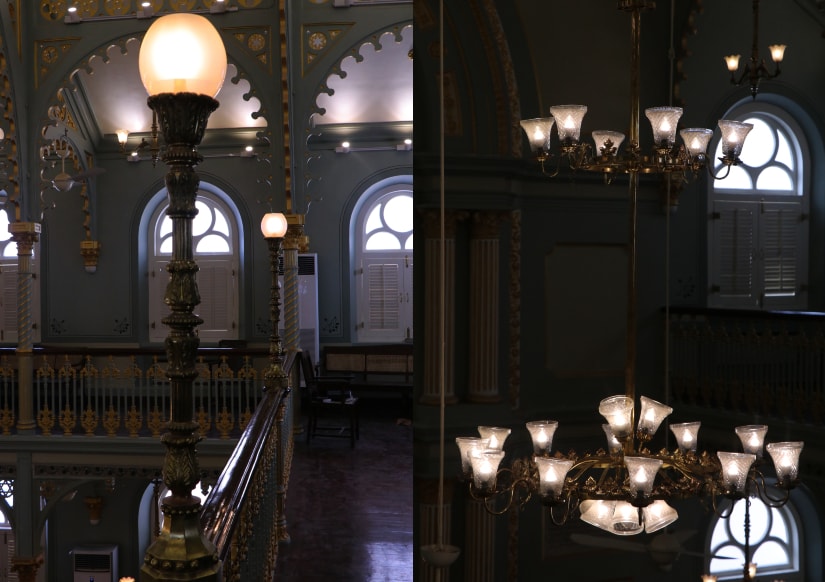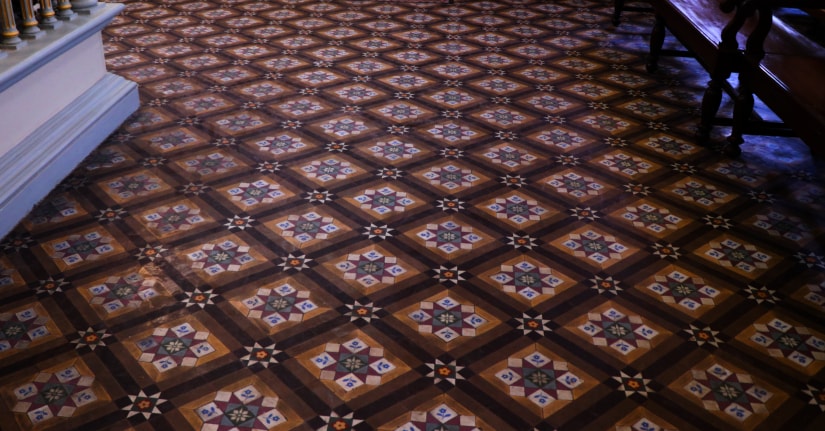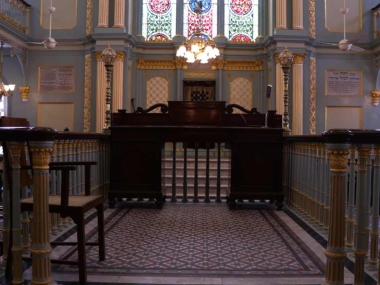Kala Ghoda is the sort of neighbourhood that inspires Mumbai-centric prose. Art galleries, a museum, warmly-lit cafes and street art define its ethos. And yet, the building that seems to rouse the most intrigue in tourists and locals is the Knesset Eliyahoo Synagogue. Its blue-coloured exterior would make it seem like it is merging with the sky above, or it would make the building stand out against adjacent structures, depending on the time of the day. But the synagogue is blue no more. Following year-long restoration work, it now wears the colours indigo and white, and is open for the public. “It’s very much a Classical Revival building, and it has been planned like a typical Baghdadi Jewish synagogue,” says Abha Narain Lambah, the principal conservation architect of the project. The restoration work was undertaken by the JSW Group, Sir Jacob Sassoon & Allied Trust, Kala Ghoda Association and the World Monument Fund. [caption id=“attachment_6057281” align=“alignnone” width=“825”]
 All photographs by Sachin Gokhale/Firstpost[/caption] From past to present Jacob Sassoon, the grandson of businessman-philanthropist David Sassoon, built the Knesset Eliyahoo Synagogue in 1884. It was designed by the British architectural firm Gostling & Morris, and was to cater to the local Baghdadi Jewish community. Kala Ghoda was specifically chosen as its location, so that the people living in areas nearby, stretching up to Colaba (where many Iraqi Jews lived), could reach it on foot. “It was built to augment prayer services for this sub-community of Jews,” says Solomon Sopher, chairman and managing trustee of the Sir Jacob & Allied Trust. Now, the city’s Baghdadi and Bene Israel Jewish communities, as well as Jews from countries outside of India, visit the synagogue. [caption id=“attachment_6057261” align=“alignnone” width=“825”]
All photographs by Sachin Gokhale/Firstpost[/caption] From past to present Jacob Sassoon, the grandson of businessman-philanthropist David Sassoon, built the Knesset Eliyahoo Synagogue in 1884. It was designed by the British architectural firm Gostling & Morris, and was to cater to the local Baghdadi Jewish community. Kala Ghoda was specifically chosen as its location, so that the people living in areas nearby, stretching up to Colaba (where many Iraqi Jews lived), could reach it on foot. “It was built to augment prayer services for this sub-community of Jews,” says Solomon Sopher, chairman and managing trustee of the Sir Jacob & Allied Trust. Now, the city’s Baghdadi and Bene Israel Jewish communities, as well as Jews from countries outside of India, visit the synagogue. [caption id=“attachment_6057261” align=“alignnone” width=“825”]
 Solomon Sopher[/caption] A sum of its parts “In terms of architectural style, we find similarities between the synagogue and the Bhau Daji Lad Museum, the Brihanmumbai Municipal Corporation’s head office, and Elphinstone College. There’s an overlap particularly between the Bhau Daji Lad Museum and the synagogue; painted stencil bands have been found in both structures,” Abha explained. The synagogue has neo-Classical and Gothic-Victorian architectural elements. Corinthian columns, a triangular roof on the external façade, semi-circular and segmented fenestrations, and cast-iron panels are notable features, as are its stained-glass panels, which feature flora and fauna motifs native to India.
Solomon Sopher[/caption] A sum of its parts “In terms of architectural style, we find similarities between the synagogue and the Bhau Daji Lad Museum, the Brihanmumbai Municipal Corporation’s head office, and Elphinstone College. There’s an overlap particularly between the Bhau Daji Lad Museum and the synagogue; painted stencil bands have been found in both structures,” Abha explained. The synagogue has neo-Classical and Gothic-Victorian architectural elements. Corinthian columns, a triangular roof on the external façade, semi-circular and segmented fenestrations, and cast-iron panels are notable features, as are its stained-glass panels, which feature flora and fauna motifs native to India.
 Lighting at the synagogue[/caption] A holistic transformation Roof repairs had to be undertaken to make the building structurally secure, and this was the first task taken up. Abha found that seepage had taken place through the walls. The original religious symbols which had become obscured under layers of blue paint, such as grapevines, citron fruit and the Star of David, have also been restored.
Lighting at the synagogue[/caption] A holistic transformation Roof repairs had to be undertaken to make the building structurally secure, and this was the first task taken up. Abha found that seepage had taken place through the walls. The original religious symbols which had become obscured under layers of blue paint, such as grapevines, citron fruit and the Star of David, have also been restored.
 Minton tiles[/caption] In such a scenario, corporate funding seems to be a necessity when it comes to ensuring heritage structures don’t suffer long-term damage. But corporate funding is far from being a new phenomenon. “The city of Mumbai is built on philanthropy. All our important structures, whether it is the Rajabai Tower that was funded by Premchand Roychand, who was a cotton merchant and banker; the convocation hall of Mumbai University and Elphinstone College that was funded by Cawasjee Jehangir; the David Sassoon Library and Sassoon Docks, funded by David Sassoon; they have been supported by merchants, bankers and entrepreneurs. It is only fair for the present-day corporate world to pitch in to restore these landmarks. David Sassoon’s efforts to build hospitals, libraries and institutes for patients of leprosy was the CSR of the 19th century,” Abha explained. Opening doors to outsiders Solomon Sopher has visited the Knesset Eliyahoo Synagogue ever since he was 12 years old. It is said that in the 1940s, as many as 3,000 Jews lived in Mumbai. Since that period, the population of Jews in the city, and indeed the rest of the country, has dwindled drastically.
Minton tiles[/caption] In such a scenario, corporate funding seems to be a necessity when it comes to ensuring heritage structures don’t suffer long-term damage. But corporate funding is far from being a new phenomenon. “The city of Mumbai is built on philanthropy. All our important structures, whether it is the Rajabai Tower that was funded by Premchand Roychand, who was a cotton merchant and banker; the convocation hall of Mumbai University and Elphinstone College that was funded by Cawasjee Jehangir; the David Sassoon Library and Sassoon Docks, funded by David Sassoon; they have been supported by merchants, bankers and entrepreneurs. It is only fair for the present-day corporate world to pitch in to restore these landmarks. David Sassoon’s efforts to build hospitals, libraries and institutes for patients of leprosy was the CSR of the 19th century,” Abha explained. Opening doors to outsiders Solomon Sopher has visited the Knesset Eliyahoo Synagogue ever since he was 12 years old. It is said that in the 1940s, as many as 3,000 Jews lived in Mumbai. Since that period, the population of Jews in the city, and indeed the rest of the country, has dwindled drastically.
Mumbai's iconic 'blue' Knesset Eliyahoo Synagogue open to public, after year-long restoration
Neerja Deodhar
• February 14, 2019, 11:43:24 IST
An example of neo-Classical architecture, the Knesset Eliyahoo Synagogue is home to beautiful stained glass panels and cast-brass lighting. Non-Jews will now be allowed to not just witness prayers here but also participate in them
Advertisement
)
The Bechal or Ark, containing the Torah scrolls, faces west towards Jerusalem, and the prayer hall is along an east to west orientation. Services are conducted from a centralised podium, built in the Sephardic, eastern Jewish tradition. The exterior is made of Porbandar stone, and Minton tiles imported from Stoke-on-Trent were laid into the floor of the synagogue’s interior. Abha was always clear that the post-restoration structure should be as close to the 19th-century design as possible. Before the restoration, the inside of the synagogue was painted blue. “We peeled off layer after layer of paint to find the oldest colour palette – the original one that was used – and decided to repaint the interiors using those colours,” Abha explains. Research and development had to be undertaken to make new paints that would match the original shades used for the interiors over a century ago. Indigo and white paint were chosen for the exteriors because they wanted an authentic colour palette – shades that are naturally occurring. “Oral history often takes over narratives, and it is as important as tangible history. People know it as the ‘blue synagogue’,” remarked Abha. It’s possible that though the colours of the structure have changed, people will still call it by its old name. The inside of the synagogue is bathed in a soft, golden light. The original lights made in cast-brass, adorned with embellishments, are the only element in the building to undergo a change. “Originally, it would have been lit by gaslight because it was built before the time of electricity. Now they have been replaced by electrical chandeliers,” Abha said. [caption id=“attachment_6057241” align=“alignnone” width=“825”]
Central to Abha’s vision for the project was that it must be holistic in nature. The funding to restore the synagogue had come as far as 10 years ago from the World Monuments Fund under the Jewish Grant Programme, but it was not adequate for the whole project. “The funds were enough only for the stained-glass panels. But I was very clear that we would only touch the stained glass when we are assured that the building is safe. Otherwise, you are paying lip service if you restore something that is fragile, if you ignore structurally distressed flaws,” she explained. Both regular maintenance and restoration are necessary for heritage buildings, Abha says. In her opinion, the community to whom the building belongs is the best stakeholder for regular maintenance. “Having said that, every hundred years, when you need major structural repairs and interventions, it does need one-time assistance.” The question of funding The total cost of the restoration was five crore rupees, and the stained glass panels (restored by Swati Chandgadkar) cost 20 lakh rupees. The biggest challenge, Abha says, was to find a sponsor. “This is a hurdle in our country, for those buildings which are not government-owned and which are religious. Since the Jews are a small community in Mumbai, they could not fund the restoration work themselves… There are so many such unsung buildings in the city.”
[caption id=“attachment_6057431” align=“alignnone” width=“825”]
At such a moment in Indian Jewish history, the opening up of the synagogue to people of all faiths, who will now be able to witness and take part in prayers too, is monumental. When it comes to allowing tourists to visit, Solomon says the community must consider the risk of terrorism. As a result, policemen have always stood guard at the synagogue (and others in the city) during the day and night. “We welcome anyone who has genuine, respectful interest,” he explained. It is incumbent on visitors to carry ID proof (think passport or PAN card), Solomon added. “The Jewish community wants nothing from India except to feel that they were always wanted,” said Solomon.
End of Article